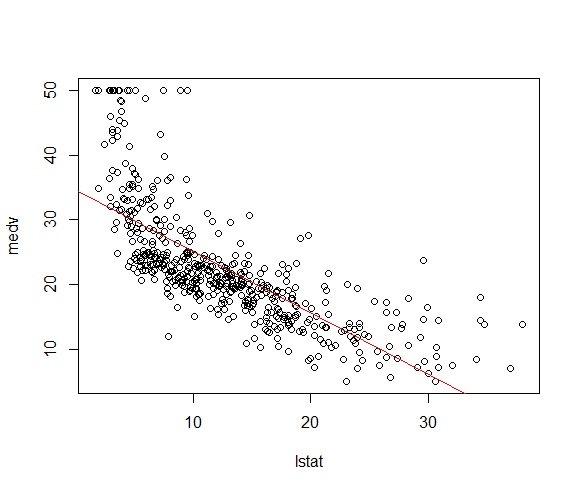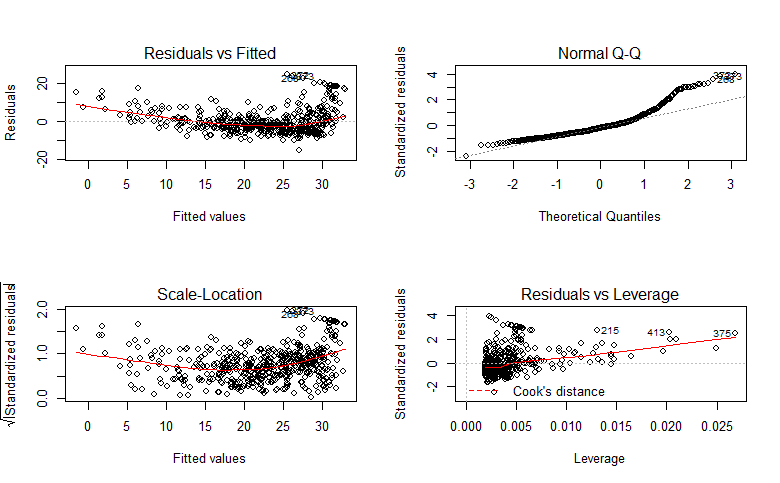ISLR系列:(1)线性回归 Linear Regression
Linear Regression
此博文是 An Introduction to Statistical Learning with Applications in R 的系列读书笔记,作为本人的一份学习总结,也希望和朋友们进行交流学习。
该书是The Elements of Statistical Learning 的R语言简明版,包含了对算法的简明介绍以及其R实现,最让我感兴趣的是算法的R语言实现。
【转载时请注明来源】:http://www.cnblogs.com/runner-ljt/
Ljt 勿忘初心 无畏未来
作为一个初学者,水平有限,欢迎交流指正。
主要内容
线性回归一章主要围绕以下7个问题进行了简明的阐述,这7个问题也是我们在建立线性模型时的基本步骤:
(1) Is there a relationship between advertising sales and budget?
(2) How strong is the relationship?
(3) Which media contribute to sales?
(4) How large is the effect of each medium on sales?
(5) How accurately can we predict future sales?
(6) Is the relationship linear?
(7) Is the synergy among the advertising media?
这七个问题又是以线性模型的建立和检验两方面为主:
这一部分的详细内容可以参考之前关于线性回归诊断的两篇博文
(一)模型的建立
(1) 自变量和因变量之间是否存在线性关系,若存在那么这种线性关系有多强?
1.整体上是否存在线性关系----回归方程显著性F检验
2.线性关系的强弱----拟合优度检验(样本决定系数R2 --R2 measures the proportion of variability in Y that can be explained using X)
(2) 哪些自变量和因变量之间存在显著的线性关系?
回归系数的显著性t检验
(二)模型检验
(1) 线性模型建立的假设是否成立?
假设1:随机干扰项 ε 服从零均值,同方差,零协方差(相互独立)的正态分布
同方差--->异方差检验 ; 零协方差--->自相关性检验 ; 正太分布--->正太性检验
假设2:模型为线性关系
线性关系--->残差图检验 ; 自变量之间是否存在高度相关--->共线性检验
(2) 样本数据检验
异常值检验:离群点检验、强影响点检验
(3) 模型预测
置信区间:因变量新值的平均值的区间预测
预测区间:因变量新值(单个值)的区间预测
建立线性模型
lm(y~x,data=Boston):线性回归拟合函数
coef(lm.fit):提取线性回归的系数
confint(lm.fit):回归系数置信区间
predict(lm.fit,data.frame(c(....)),interval='confidence') :置信区间
predict(lm.fit,data.frame(c(....)),interval='prediction') :预测区间
>
> library(MASS)
> library(ISLR)
> head(Boston)
crim zn indus chas nox rm age dis rad tax ptratio black lstat medv
1 0.00632 18 2.31 0 0.538 6.575 65.2 4.0900 1 296 15.3 396.90 4.98 24.0
2 0.02731 0 7.07 0 0.469 6.421 78.9 4.9671 2 242 17.8 396.90 9.14 21.6
3 0.02729 0 7.07 0 0.469 7.185 61.1 4.9671 2 242 17.8 392.83 4.03 34.7
4 0.03237 0 2.18 0 0.458 6.998 45.8 6.0622 3 222 18.7 394.63 2.94 33.4
5 0.06905 0 2.18 0 0.458 7.147 54.2 6.0622 3 222 18.7 396.90 5.33 36.2
6 0.02985 0 2.18 0 0.458 6.430 58.7 6.0622 3 222 18.7 394.12 5.21 28.7
>
> attach(Boston)
> lm.fit<-lm(medv~lstat)
> summary(lm.fit) Call:
lm(formula = medv ~ lstat) Residuals:
Min 1Q Median 3Q Max
-15.168 -3.990 -1.318 2.034 24.500 Coefficients:
Estimate Std. Error t value Pr(>|t|)
(Intercept) 34.55384 0.56263 61.41 <2e-16 ***
lstat -0.95005 0.03873 -24.53 <2e-16 ***
---
Signif. codes: 0 ‘***’ 0.001 ‘**’ 0.01 ‘*’ 0.05 ‘.’ 0.1 ‘ ’ 1 Residual standard error: 6.216 on 504 degrees of freedom
Multiple R-squared: 0.5441, Adjusted R-squared: 0.5432
F-statistic: 601.6 on 1 and 504 DF, p-value: < 2.2e-16 > names(lm.fit)
[1] "coefficients" "residuals" "effects" "rank" "fitted.values" "assign"
[7] "qr" "df.residual" "xlevels" "call" "terms" "model"
>
> #回归系数
> coef(lm.fit)
(Intercept) lstat
34.5538409 -0.9500494
> #回归系数的置信区间
> confint(lm.fit)
2.5 % 97.5 %
(Intercept) 33.448457 35.6592247
lstat -1.026148 -0.8739505
> #预测:置信区间和预测区间
> predict(lm.fit,data.frame(lstat=c(5,10,15,20)),interval='confidence')
fit lwr upr
1 29.80359 29.00741 30.59978
2 25.05335 24.47413 25.63256
3 20.30310 19.73159 20.87461
4 15.55285 14.77355 16.33216
> predict(lm.fit,data.frame(lstat=c(5,10,15,20)),interval='prediction')
fit lwr upr
1 29.80359 17.565675 42.04151
2 25.05335 12.827626 37.27907
3 20.30310 8.077742 32.52846
4 15.55285 3.316021 27.78969
>
>
线性模型检验
abline(lm.fit):画回归拟合直线
plot(lm.fit):画回归诊断图(残差图、Q-Q图、标准化残差图、杠杆图)
par(mfrow=c(2,3)):图板分区
>
> #测试数据散点图
> plot(lstat,medv)
> #画回归拟合直线
> abline(lm.fit,col='red')
>
> #诊断图
> #图板分区
> par(mfrow=c(2,2))
>
> plot(lm.fit)
>


残差图和标准化残差图显示有明显的非线性关系,杠杆图表明第375个样本点是高杠杆点。
多元线性回归
summary(lm.fit)$r.sq:提取回归方程的决定系数R2 ;通过?summary.lm 查看可提取的信息
vif(lm.fit):查看方差扩大因子(一般回归方程的方差扩大因子大于10的几个变量间存在着多重共线性),需要加载car包。
>
> #多元线性回归
> lm.fit<-lm(medv~lstat+age,data=Boston)
> summary(lm.fit) Call:
lm(formula = medv ~ lstat + age, data = Boston) Residuals:
Min 1Q Median 3Q Max
-15.981 -3.978 -1.283 1.968 23.158 Coefficients:
Estimate Std. Error t value Pr(>|t|)
(Intercept) 33.22276 0.73085 45.458 < 2e-16 ***
lstat -1.03207 0.04819 -21.416 < 2e-16 ***
age 0.03454 0.01223 2.826 0.00491 **
---
Signif. codes: 0 ‘***’ 0.001 ‘**’ 0.01 ‘*’ 0.05 ‘.’ 0.1 ‘ ’ 1 Residual standard error: 6.173 on 503 degrees of freedom
Multiple R-squared: 0.5513, Adjusted R-squared: 0.5495
F-statistic: 309 on 2 and 503 DF, p-value: < 2.2e-16 >
> lm.summary<-summary(lm.fit)
> #提取R^2
> lm.summary$r.sq
[1] 0.5512689
>
> ##方差扩大因子
> library(car)
> vif(lm.fit)
lstat age
1.569395 1.569395
>
非线性
lm(y~x1+x2+x1:x2) : x1:x2 只表示x1.x2 ; x1*x2 表示x1+x2+x1.x2 ;
lm(y~x+I(x^2)) : 在lm(...)内表示变量的高次项 I(x^2),直接用x^2是错误的。
>
>
> ##变量间的交互项
>
> lm.fit<-lm(medv~lstat+age+lstat:age,data=Boston)
> summary(lm.fit) Call:
lm(formula = medv ~ lstat + age + lstat:age, data = Boston) Residuals:
Min 1Q Median 3Q Max
-15.806 -4.045 -1.333 2.085 27.552 Coefficients:
Estimate Std. Error t value Pr(>|t|)
(Intercept) 36.0885359 1.4698355 24.553 < 2e-16 ***
lstat -1.3921168 0.1674555 -8.313 8.78e-16 ***
age -0.0007209 0.0198792 -0.036 0.9711
lstat:age 0.0041560 0.0018518 2.244 0.0252 *
---
Signif. codes: 0 ‘***’ 0.001 ‘**’ 0.01 ‘*’ 0.05 ‘.’ 0.1 ‘ ’ 1 Residual standard error: 6.149 on 502 degrees of freedom
Multiple R-squared: 0.5557, Adjusted R-squared: 0.5531
F-statistic: 209.3 on 3 and 502 DF, p-value: < 2.2e-16 >
> ##变量的高次项
> lm.fit2<-lm(medv~lstat+I(lstat^2))
> summary(lm.fit2) Call:
lm(formula = medv ~ lstat + I(lstat^2)) Residuals:
Min 1Q Median 3Q Max
-15.2834 -3.8313 -0.5295 2.3095 25.4148 Coefficients:
Estimate Std. Error t value Pr(>|t|)
(Intercept) 42.862007 0.872084 49.15 <2e-16 ***
lstat -2.332821 0.123803 -18.84 <2e-16 ***
I(lstat^2) 0.043547 0.003745 11.63 <2e-16 ***
---
Signif. codes: 0 ‘***’ 0.001 ‘**’ 0.01 ‘*’ 0.05 ‘.’ 0.1 ‘ ’ 1 Residual standard error: 5.524 on 503 degrees of freedom
Multiple R-squared: 0.6407, Adjusted R-squared: 0.6393
F-statistic: 448.5 on 2 and 503 DF, p-value: < 2.2e-16 >
> ##方差分析
> lm.fit1<-lm(medv~lstat)
>
> anova(lm.fit1,lm.fit2)
Analysis of Variance Table Model 1: medv ~ lstat
Model 2: medv ~ lstat + I(lstat^2)
Res.Df RSS Df Sum of Sq F Pr(>F)
1 504 19472
2 503 15347 1 4125.1 135.2 < 2.2e-16 ***
---
Signif. codes: 0 ‘***’ 0.001 ‘**’ 0.01 ‘*’ 0.05 ‘.’ 0.1 ‘ ’ 1
>
>
定性变量
contrasts(...) : 查看及设置虚拟变量
>
> head(Carseats)
Sales CompPrice Income Advertising Population Price ShelveLoc Age Education Urban US
1 9.50 138 73 11 276 120 Bad 42 17 Yes Yes
2 11.22 111 48 16 260 83 Good 65 10 Yes Yes
3 10.06 113 35 10 269 80 Medium 59 12 Yes Yes
4 7.40 117 100 4 466 97 Medium 55 14 Yes Yes
5 4.15 141 64 3 340 128 Bad 38 13 Yes No
6 10.81 124 113 13 501 72 Bad 78 16 No Yes
>
> lm.fit<-lm(Sales~CompPrice+Income+ShelveLoc,data=Carseats)
> summary(lm.fit) Call:
lm(formula = Sales ~ CompPrice + Income + ShelveLoc, data = Carseats) Residuals:
Min 1Q Median 3Q Max
-7.5611 -1.6096 -0.1409 1.6263 6.1845 Coefficients:
Estimate Std. Error t value Pr(>|t|)
(Intercept) 2.875874 1.023857 2.809 0.00522 **
CompPrice 0.010634 0.007489 1.420 0.15638
Income 0.018388 0.004111 4.473 1.01e-05 ***
ShelveLocGood 4.750942 0.340955 13.934 < 2e-16 ***
ShelveLocMedium 1.861994 0.280481 6.639 1.05e-10 ***
---
Signif. codes: 0 ‘***’ 0.001 ‘**’ 0.01 ‘*’ 0.05 ‘.’ 0.1 ‘ ’ 1 Residual standard error: 2.285 on 395 degrees of freedom
Multiple R-squared: 0.3519, Adjusted R-squared: 0.3454
F-statistic: 53.63 on 4 and 395 DF, p-value: < 2.2e-16 >
> ##查看虚拟变量
> contrasts(Carseats$ShelveLoc)
Good Medium
Bad 0 0
Good 1 0
Medium 0 1
>
ISLR系列:(1)线性回归 Linear Regression的更多相关文章
- 机器学习方法:回归(一):线性回归Linear regression
欢迎转载,转载请注明:本文出自Bin的专栏blog.csdn.net/xbinworld. 开一个机器学习方法科普系列:做基础回顾之用,学而时习之:也拿出来与大家分享.数学水平有限,只求易懂,学习与工 ...
- TensorFlow 学习笔记(1)----线性回归(linear regression)的TensorFlow实现
此系列将会每日持续更新,欢迎关注 线性回归(linear regression)的TensorFlow实现 #这里是基于python 3.7版本的TensorFlow TensorFlow是一个机器学 ...
- Stanford机器学习---第二讲. 多变量线性回归 Linear Regression with multiple variable
原文:http://blog.csdn.net/abcjennifer/article/details/7700772 本栏目(Machine learning)包括单参数的线性回归.多参数的线性回归 ...
- 机器学习(三)--------多变量线性回归(Linear Regression with Multiple Variables)
机器学习(三)--------多变量线性回归(Linear Regression with Multiple Variables) 同样是预测房价问题 如果有多个特征值 那么这种情况下 假设h表示 ...
- Ng第二课:单变量线性回归(Linear Regression with One Variable)
二.单变量线性回归(Linear Regression with One Variable) 2.1 模型表示 2.2 代价函数 2.3 代价函数的直观理解 2.4 梯度下降 2.5 梯度下 ...
- 斯坦福第二课:单变量线性回归(Linear Regression with One Variable)
二.单变量线性回归(Linear Regression with One Variable) 2.1 模型表示 2.2 代价函数 2.3 代价函数的直观理解 I 2.4 代价函数的直观理解 I ...
- 斯坦福CS229机器学习课程笔记 Part1:线性回归 Linear Regression
机器学习三要素 机器学习的三要素为:模型.策略.算法. 模型:就是所要学习的条件概率分布或决策函数.线性回归模型 策略:按照什么样的准则学习或选择最优的模型.最小化均方误差,即所谓的 least-sq ...
- 机器学习 (一) 单变量线性回归 Linear Regression with One Variable
文章内容均来自斯坦福大学的Andrew Ng教授讲解的Machine Learning课程,本文是针对该课程的个人学习笔记,如有疏漏,请以原课程所讲述内容为准.感谢博主Rachel Zhang的个人笔 ...
- 机器学习 (二) 多变量线性回归 Linear Regression with Multiple Variables
文章内容均来自斯坦福大学的Andrew Ng教授讲解的Machine Learning课程,本文是针对该课程的个人学习笔记,如有疏漏,请以原课程所讲述内容为准.感谢博主Rachel Zhang 的个人 ...
- ML 线性回归Linear Regression
线性回归 Linear Regression MOOC机器学习课程学习笔记 1 单变量线性回归Linear Regression with One Variable 1.1 模型表达Model Rep ...
随机推荐
- Codeforces Round #305 (Div. 2) A. Mike and Fax 暴力回文串
A. Mike and Fax Time Limit: 20 Sec Memory Limit: 256 MB 题目连接 http://codeforces.com/contest/548/pro ...
- Python3 JSON 数据解析
JSON (JavaScript Object Notation) 是一种轻量级的数据交换格式.它基于ECMAScript的一个子集. Python3 中可以使用 json 模块来对 JSON 数据进 ...
- Bootstrap3 表单-水平排列的表单
通过为表单添加 .form-horizontal 类,并联合使用 Bootstrap 预置的栅格类,可以将 label 标签和控件组水平并排布局.这样做将改变 .form-group 的行为,使其表现 ...
- Gradle 1.12用户指南翻译——第五十三章. 签名插件
其他章节的翻译请参见:http://blog.csdn.net/column/details/gradle-translation.html翻译项目请关注Github上的地址:https://gith ...
- Bootstrap3 排版-标题
HTML 中的所有标题标签,<h1> 到 <h6> 均可使用.另外,还提供了 .h1 到 .h6 类,为的是给内联(inline)属性的文本赋予标题的样式. h1. Boots ...
- Ajax原理学习
一.AJAX 简介 AJAX即"Asynchronous Javascript And XML"(异步JavaScript和XML),是指一种创建交互式网页应用的网页开发技术. A ...
- Unable to ignore resources
摘要:分享牛,分享牛系列, Unable to ignore resources Attempted to beginRule: 异常信息处理. 出现Unable to ignore resource ...
- python模块collections中namedtuple()的理解
Python中存储系列数据,比较常见的数据类型有list,除此之外,还有tuple数据类型.相比与list,tuple中的元素不可修改,在映射中可以当键使用.tuple元组的item只能通过index ...
- Android布局概述
布局 布局定义用户界面的视觉结构,如Activity或应用小部件的 UI.您可以通过两种方式声明布局: 在 XML 中声明 UI 元素.Android 提供了对应于 View 类及其子类的简明 XML ...
- android的activity栈管理
在进行BlackBerry程序开发的时候,BlackBerry提供了一个管理Screen的栈,用来从任何地方来关闭位于最上一层的Screen,使用UiApplication.getUiApplicat ...
